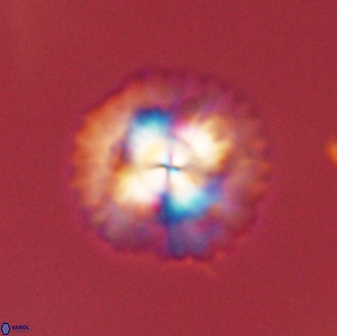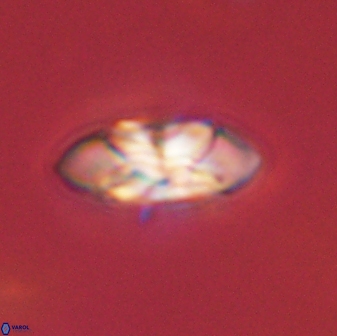Senelia plevrotos
Senelia plevrotos Varol, 2023
A large species (8.0–12.0 μm) of Senelia possessing a nonbirefringent lenticular distal shield, a tube cycle with a distinctly serrated margin and an appressed proximal shield.
From Greek plevrotos, rib – refers to the tube cycle’s appearance with its proximal shield in side view.
Diameter of the distal shield: 9.32 μm, the diameter of the proximal shield: 5.00 μm, the diameter of the tube cycle: 5.00 μm (all measured in side view in cross-polarised light with a gypsum plate), the height of the distal shield and tube cycle: 3.59 μm.
The distal shield and the tube cycle are constructed of similar segments (between 26 and 40). The tube cycle is flush with the distal end of the distal shield, and its diameter is often slightly greater than or equal to the width of the shield. The combination of the tube cycle and appressed proximal shield resembles a rib-like structure (X-shape) in side view (Plate 17, Figs. 2,6 in Varol, 2023).
In cross-polarised light, with the gypsum plate inserted, the blue sectors are aligned to the horizontal axis on the distal side (Pl 17, Figs. 7,14,23 in Varol, 2023). In contrast, the blue sectors are aligned to the vertical axis on the proximal side (Pl 17, Fig. 15 in Varol, 2023). Senelia plevrotos displays inclined laevogyre extinction lines distally (Plate 17, Figs. 10,14 in Varol, 2023) but inclined dextrogyre extinction lines proximally (Plate 17, Figs. 11,15 in Varol, 2023). The entire specimen appears birefringent, and the distal shield displays rounded ends in side view.
In plan view, Senelia plevrotos is distinguished from Senelia perifanos by having a tube cycle with a distinctly serrated margin. Its diameter is slightly greater or about equal to the width of the shield. Senelia perifanos has a much wider, smooth-appearing tube cycle whose diameter is at least twice the width of the shield. In the side view, the distal shield has rounded ends in Senelia plevrotos, whereas the distal shield has pointed ends in Senelia perifanos.
Senelia plevrotos differs from the species of Noelia by lacking a distally protruding tube cycle above the distal shield. Senelia plevrotos is distinguished from Davidbukrya and Carlamuelleria by having an appressed proximal shield. There is no proximal shield in Davidbukrya, but a vestigial, diminutive proximal shield in Carlamuelleria.
Varol, O. 2023. New paleocene calcareous nannofossils: Carlamuelleria, Davidbukrya, Mauriceblackia, Noelia and Senelia. Marine Micropaleontology. 180: 1-41.



